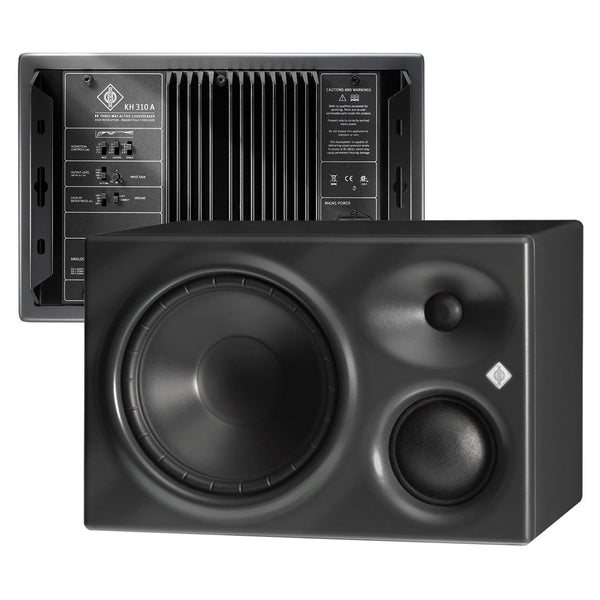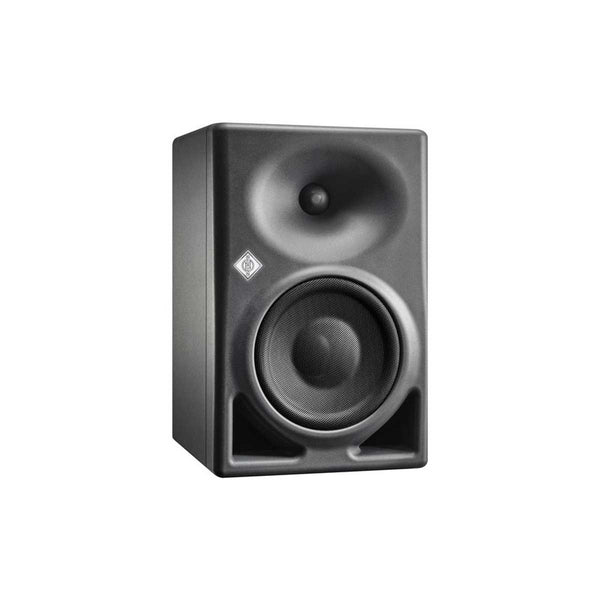- Joined
- Jan 7, 2020
- Messages
- 950
- Likes
- 1,265
yes, I recently bought a pair of KH310 for $A5000 in Perth from another dealer
Awesome! Totally unbeatable at that price.
How are you using them?
yes, I recently bought a pair of KH310 for $A5000 in Perth from another dealer
Is that the AES67 version of the 150?
Neumann KH 310 A - Active Studio Monitor (Left)
The KH 310 A three-way active tri-amplified monitor features Neumann's outstanding "Mathematically Modeled Dispersion Waveguide".www.soundseasy.com.au

Neumann KH 150 Studio Monitor (Single)
Powerful bi-amplified studio monitor with reference-class performance. Its 6.5” woofer in a bass reflex cabinet provides stunning low end and high SPL capability with undiminished clarity. DSP controlled electronics ensure linear phase response and allow for room-adaptive calibration via...www.soundseasy.com.au
With the exception of the KEF R3 (which scores similarly/within margin of error), the Philharmonic BMR measures better than virtually all of these that have already been measured in the spinorama database with its predicted higher pref score. Can we really make assumptions about the presence or absence of a waveguide on preference when it's already winning by virtue of number of other simple metrics that predict preference?Interestingly, Dennis Murphy's BMR Monitor 3-way was (no waveguide) was preferred to a wide variety of other sub US$3000 book-shelf speakers including the those bought in by dealers. I don't think anyone expected that, except for maybe Dennis, who eschews the use of waveguides. This was at the recent Arizona AV Club event.
The speakers were:
ATC SCM 11
KLH Model 5
KEF R3
Sonus Faber Lumina II
Totem Sky
Philharmonic BMR Monitors
Polk Audio Legend L200
LSA Signature 80
Tekton Design Impact Monitors,
Monitor Audio 100 Gold,
Buchardt Audio S400 MkII
Triangle Comete 40th Anniversary
GoldenEar BRX
GR-Research X-LS Encore
Falcon Acoustics Q7
SpeakerLab Point 1+
Just because it has a waveguide doesn't mean it's better. I agree.
Anyway, guess I better get back to finishing these, with that ol' tool VituixCAD2

DIY 2-way with complete spinorama / CTA2034A measurements - Purifi and Scan-Speak
Project brief- To design a small speaker with a big sound, with the aid of the Klippel Near Field Scanner for complete measurements in 360 degrees! Classic 1/2 cubic foot (14L) 2 way with 6.5" midwoofer / 1" tweeter, stand-mount Driver selection: Midwoofer: Purifi 6.5" Xtended x-max aluminium...www.audiosciencereview.com
best regards,
Thanh
Awesome! Totally unbeatable at that price.
How are you using them?
I'm from Israel and everything is crazy expensive here lolThat’s great. Sometimes we do get little wins from the Australia tax.
My wild guess is that about 80% of things cost far more here, than than how much they cost in Europe.
Most of the time we’re like the Middle East, or Israel!!
With the exception of the KEF R3 (which scores similarly/within margin of error), the Philharmonic BMR measures better than virtually all of these that have already been measured in the spinorama database with its predicted higher pref score. Can we really make assumptions about the presence or absence of a waveguide on preference when it's already winning by virtue of number of other simple metrics that predict preference?
From:Each speaker was placed in the same position on the same stands, and those who entered a raffle were then asked to list their 1st, second, and third choices. 52 people voted. The BMR received 29 1st choice ballots. The runner up was the Triangle with 6 votes. The KEF R3 received 3 votes, and the ATC and Buchardt 2 each.
Reasoning by analogy is another pointless exercise. Like the endless comparisons of audio manufacturing to car manufacturing.What data do you have, or is out there, that explains why headphones are preferable to speakers?
Or evidence do you have that explains why speakers are preferable to headphones?

That member is Kimmo Saunisto, the developer of the leading CAD software for loudspeaker design:
Dennis Murphy, who eschews the use of waveguides, has 30 years of experience designing loudspeakers.

Philharmonic Audio
www.philharmonicaudio.com
When they something, I listen with an open mind.
I prefer the sound of Genelec’s 2-way speakers, the ones WITH the waveguides, to their One series, the ones with the coaxials. Why? I do not (yet) know. Could it be that everything below 300Hz is played into the back of an aluminium baffle, causing some kind of smearing? Or some other effect? Or could my eyes be playing tricks on me?
I do not (yet) know.
I do not (yet) have a good test for my hypothesis.
Just because there isn’t yet strong evidence, doesn’t mean there couldn’t be a truth to it. It just means that there’s not yet strong evidence to it.
ie. way to measure it and analyse it with a confidence level of p<0.05.
First comes observation. Then hypothesis. Then devising a test for said hypothesis. Then rinse and repeat. That’s the scientific method.
What evidence do you have, or have seen, that says waveguide has equal preference to to no waveguide. ie. Null hypothesis?
Quit demanding evidence when we may actually be in an evidence free zone, for now…
At least look up some papers. I'll even give you a headstart: Geddes' papers on waveguides and higher order modes (the issue being that in waveguides you get a combo of direct sound and sound that bounces off the sloped walls; these ultraearly reflections he claims are audible). More generally, there are studies on wave propagation in hornspeakers that are also interesting.That member is Kimmo Saunisto, the developer of the leading CAD software for loudspeaker design.
Dennis Murphy, who eschews the use of waveguides, has 30 years of experience designing loudspeakers.

Philharmonic Audio
www.philharmonicaudio.com
I prefer the sound of Genelec’s 2-way speakers, the ones with the waveguides, to their One series, the ones with the coaxials. Why? I do not (yet) know. Could it be that everything below 300Hz is played into the back of an aluminium baffle, causing smearing? Or some other effect?
I do not (yet) know.
I do not (yet) have a good test for my hypothesis?
Just because there isn’t yet strong evidence, doesn’t mean there couldn’t be a truth to it. It just means that there’s not yet strong evidence to it. ie. way to measure it and analyse it with a confidence level of p<0.05.
First comes observation. Then hypothesis. Then devising a test for said hypothesis. Then rinse and repeat.
What evidence do you have, or have seen, that says waveguide is equal to no waveguide. ie. Null hypothesis?
Quit demanding evidence when we may be in an evidence free zone, for now…
17W at idle is outrageous! What the fuck? That’s not class D.You spend so much time here on these monitors, haven't looked at the manufacturer website yet?
ENERGY EFFICIENT
Neumann engineers took great care to develop a patent pending amplifier technology which combines superior audio performance with the energy efficiency of Class D. Although the KH 150’s amplifiers deliver up to 145 W to the 6.5” woofer and 100 W to the 1” tweeter, they only consume 17 W at idle. Auto-standby reduces power consumption to 0.3 W when the KH 150 has not been used for a while, but can be deactivated.
Source: https://en-de.neumann.com/kh-150
Very thin skinned of you.Curvature I’m going to ignore your condescending tone and instead assume that something I wrote has made you somewhat irate, I already know about Geddes and his HOM since he burst into the scene, so you don’t need to throw me a bone by suggesting only a couple of papers.
Is it easier to design speakers than studying them, is it? What evidence do you have that?
I’m out.
Few questions:What I'd like is to understand your claims with you supplying the data that convinced you that deep waveguides sound unnatural and that traditional mounting is better.
You are introducing a lot of superficial considerations into a simple question. I asked you for data that you've found that supports your opinion that deep waveguides sound unnatural—and the KH150 is a speaker with a deep waveguide. I'm still asking for just that. I even posted some data that potentially supports your opinion with the references to higher order modes.Few questions:
1) What are main targets for horns / wave guides?
2) Is there alternative solution(s) for horn / wave guide to achieve majority of main targets, and what they are?
3) What is average EDT in your listening room? Is decay spectrum balanced/flat or not?
4) What listening distance you prefer?
5) What acoustic resolution as octave transmission index (of STI analysis) is achieved at typical listening point?
6) How many other speaker+listening room -combinations you have investigated by measurements and what are the results?
7) What are (subjective) consequences if directivity index is 0 dB at LF and 10...15 dB at HF in reflecting environment?
8) Do you prefer DI rise of ca. 10 dB from LF to HF or much less for example max 5 dB?
9) How many significantly different directivity concepts you have evaluated by listening?
10) What coffee roast and ice cream you prefer? Show data, not just obscure opinions.
P.S. I have never said that KH150 has design flaw so please don't twist my words. Using horn / horn wave guide is just one "design point" - a compromise with certain assumptions about environment and listening setup and constraints related mechanical design (size and shape). I really don't have to like or design speakers with that concept, but I can easily use it as a design reference and listen music with it.
Hard not to read that as signaling flaw when considering the KH150's design.I'm not big fan of horns and wave guides - especially deep ones because sound is not very open and natural and spectrum of acoustic resolution rises towards HF without significant directivity at LF. Plain tweeter with proper box or flush mounted half space design in a good acoustics offers better sound imo. Horn/wave guide concept can offer some benefits in very bad/harsh acoustics of course.
All I'm really asking for is some data or evidence which—separate from speaker directivity in general—shows that waveguides produce unnatural, not open, etc., sound. If all you are really talking about is directivity, then fine, all's clear and the conversation is over. But if you are saying that waveguides have some kind intrinsic weaknesses that produce a characteristic sound, then I want to know what that means.With measurements you can investigate the contribution of design features and judge how much they matter.
